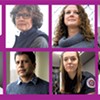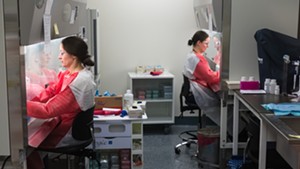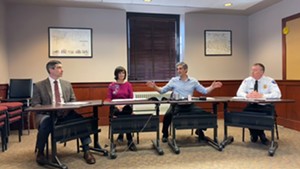Editor's note: Seven Days
is profiling some of the people defending Vermonters from COVID-19. This is the first of several stories.
Patsy Kelso touches her face too much. The state epidemiologist for infectious disease at the Vermont Department of Health confessed as much in a recent phone call to Seven Days from her Burlington office. “As we speak, I’m leaning my chin on my hand,” she said with an exasperated chuckle. “It’s really hard not to,” she continued, “but I am more attentive to it, which is a good first step.”
Obviously, COVID-19 is no laughing matter, most especially for the woman in charge of coordinating the state’s massive efforts to slow its spread. But that even she has a hard time keeping her mitts off her mug — one of the many recommended precautions against contracting the disease — throws into relief just how daunting it can be to handle even the smallest challenges related to the virus, never mind the major ones.
Most prominent among the latter in the early stages of the COVID-19 outbreak is disease containment.
“We’re not at all thinking that we’re going to be able to stop the spread of transmission in Vermont,” Kelso said. “But we’re thinking we can slow it down, for sure.”
Kelso has been a senior epidemiologist with the Vermont Department of Health for 20 years. For the last 11 of those, she has served as the state epidemiologist, overseeing Vermont’s infectious disease programs. In that time, she’s experienced her share of hot-button public health crises. Most notable was the novel influenza H1N1, or “swine flu,” in 2009 that killed more than 200,000 people globally.
Preparations for that health scare and others — including a whooping cough outbreak in 2012, Ebola in 2014 and tuberculosis in 2015 — have helped create a framework for how the state’s health care system would respond in the event of an epidemic. Those events, which had a relatively minor impact in Vermont, offered practice runs in setting up and operating a long-term health operations center, monitoring returning travelers for symptoms, implementing Centers for Disease Control and Prevention guidance, and providing recommendations to clinicians, businesses and schools.
All of those are facets in Vermont’s approach to COVID-19. The difference, according to Kelso, is scale.
“I’ve never seen a response so big, where we’ve had to pull in so many people from across the department to fill roles that are so different from their day-to-day work,” she said.
Kelso’s department typically staffs 10 epidemiologists. Currently, 15 more people, including nurses and epidemiologists from other departments, are working in the health operations center, largely to handle the extreme volume of inquiries from the public about the disease.
“There are extra phones everywhere,” she revealed. “Everybody has questions about how this is going to affect them.”
On that topic, Kelso spoke bluntly.
“I think we’re going to see a fairly large impact over time,” she said, adding that she expects to see a lot more cases of COVID-19 in Vermont.
The good news, she continued, is that “about 80 percent” of infected people will experience minor to moderate symptoms. The rest, she said, especially people over 60 and those with underlying health conditions, “are at higher risk for severe illness.” That’s a concern in a state where more than 19 percent of the population is over 65.
Kelso noted that accurate fatality rate data about COVID-19 is still unavailable because the virus is new. She cautioned that it could be deadlier than the flu.
“We may, in fact, see deaths in Vermont, and more deaths in the U.S.,” Kelso said. “That’s just because this is a brand-new virus to humans, and there’s no immunity in the population.”
Which makes containment critical, she explained. Failure could lead to large numbers of sick Vermonters overwhelming the state’s health care system. But slowing transmission could ease a surge.
“We may end up with the same number of cases in the long run,” Kelso said, “but the impact on the health care system will be lessened.”


















Comments (4)
Showing 1-4 of 4
Comments are closed.
From 2014-2020, Seven Days allowed readers to comment on all stories posted on our website. While we've appreciated the suggestions and insights, right now Seven Days is prioritizing our core mission — producing high-quality, responsible local journalism — over moderating online debates between readers.
To criticize, correct or praise our reporting, please send us a letter to the editor or send us a tip. We’ll check it out and report the results.
Online comments may return when we have better tech tools for managing them. Thanks for reading.